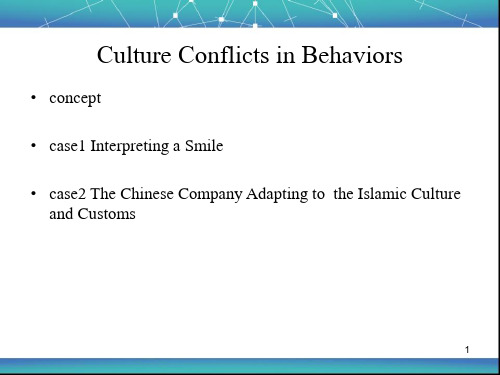跨文化商务沟通の课件总结
跨文化商务沟通(PPT32页)

Character features
South China: exquisite, euphemistic North China:bold, frank,straightforward
7
Islam
Dietary restrictions: • do not eat pork • do not drink • do not eat blood
28
Analysis
• The delegators from Dubai belief in Islamism, and have strong religious concepts. Boar is their totem, they are banned from eating pork.
• Chinese people lack of religious conscious and ignore the important factor when they negotiate with Dubai’s company.
different cultures, customs and religious belief different thoughts or actions conflicts
2
Types
Verbal behaviors
Different ways of greeting Different responds to praise The main part of considering issues
跨文化商务沟通PPT课件

本章主题
• 全球化、全球本土化以及增长 • 文化 • 社会文化适应 • 文化适应 • 民族中心主义 • 规范、规章、角色和人际关系 • 亚文化和亚群体 • 文化智力 • 沟通障碍 • 跨文化构念 • 全球化思维方式 • 跨国公司管理方向
1-2
1.1 全球化、全球本土化以及 增长全球化
• 全球化
– 全球化就是通过社会和商业两种途径传播生活方式。
• 全球本土化
– 全球本土化指的是“全球和本土的相互渗透,会在不同地 理区域导致独特的结果”。
• 增长全球化
– 增长全球化指通用的规范和惯例从一个地方向另一个地方 的扩展。换句话说,它就是给一个群体强加上一种新文化。
1-3
1.2 文化
• 文化及其维度
• 地心主义管理
– 地心主义管理要有一个各个国家通用的结构,以便各个地方 的分公司有足够的自由运营来满足工人的文化需求。
1-20
1.12 跨国公司管理方向
• 走向国际的十诫
– 准备好。 – 提问题,细心倾听。 – 不断努力;尝试而发生错误要好于不尝试。 – 当问题出现,假设主要原因是误传。 – 要有耐心;在另一个国家或者文化背景下完成你的目标,往
• 后台文化
– 想向圈外人掩藏的文化称为后台文化。后台文化的一个例 子就是一位销售代表隐瞒他的孩子有智力缺陷。
1-7
1.4 文化适应
• 文化适应
– 文化适应是调整和适应一种新的不同文化的过程。
• 文化协同
– 如果两种不同文化背景的人吸收了彼此大量的文化差异并 且有很多相似的地方,文化协同就产生了,即两种文化融 合形成一种更强大的具有压倒性的文化。
者政治优势。 – 非常看重合同和写出来的文字内容。 – 意识到组织内的地位差异。 – 易变动。 – 在他们的行为中传达出一种优越感。
商务沟通中的跨文化沟通 (ppt 36页)

11.10.2019
24
三、沟通中的阿拉伯人
对阿拉伯地区的商务沟通上的注意点有 所了解,对在整个中东地区的沟通都有 帮助。
阿拉伯地区是个复杂的地方,无论是它 的政治、经济,还是文化。这是这种复 杂性会让你在不经意间触到了“高压 线”。
11.10.2019
25
1.宗教特色
宗教在阿拉伯国家占据极其重要地位。
种语言说得好到以用来处理复杂的商业 谈判。英语不流利的商人应该考虑聘请 一位翻译。 谈判风格——沉默、平静、自信、谨慎
11.10.2019
32
三、沟通中的法国文化
关系第一
注重地位
餐饮特色
语言————在法国,商务语言一定是 法语 。
谈判风格——与法国人洽谈生意时,不 应只顾谈生意上的事务与细节,否则很 容易被法国对手视为没有情趣。
19
1.印度文化
四大文明古国之一的印度有着鲜明的民族特 色
官僚主义
等级制度——印度自古就有很森严的等级制 度,而且这种与生俱来的等级地位不能像在 中国一样通过考取功名之类的方式得到改变。
11.10.2019
20
《贫民窟的百万富翁》主角剧照与生活照
11.10.2019
21
关系第一——和日本一样,印度的商业 行为也是关系导向型,不过由于印度商 人的商业意识远没有日本人的那么浓, 在这里的关系第一就更加重要,更加强 调朋友交情。
11.10.2019
26
2.风俗习惯
个人空间意识——阿拉伯地区个人距离 较小。
时间观念——在海湾地区,耐心是个重 要的美德。
11.10.2019
27
宴请——吃饭时,一定要吃很多,以表 示你的感激之情。
第12章 跨文化沟通 《商务沟通》PPT课件

(5)礼仪
– 不同文化对于收到礼物的种类、数量、颜色和形状所表达的 意思,可能会有不同的理解和解释。
– 不同文化对于礼物价值大小的感受和要求也会有很大的差异。
12.3 跨文化沟通技能
12.3.1 掌握跨文化沟通习惯差异
– 1.跨文化沟通中的礼节
美国人谈判讲究效率,经常单刀直入到事件的核心。北美谈判者的基本风 格是坚持事实倾向的。他们会基于自己所相信的客观事实,并相信对方也 会合乎逻辑地理解,据此向对方传递信息,开展谈判。
阿拉伯谈判者的基本风格是感情倾向的。他们会基于自身的主观感情和感 受来开展谈判。阿拉伯人喜欢成为长期的合作伙伴,因而更易于做出让步。 阿拉伯人对时限不够重视。
• (1)称呼
– 不同文化中正确地称呼对方都是非常重要的。 – 要正确地称呼对方,前提是要记住对方名字,而且称呼方式正确。
• (2)衣着仪表
– 跨文化沟通中,应当穿着显得比较自然的服饰,而且要使穿戴与周围环境相 协调。
– 在跨文化沟通中要绝对避免和防止因穿着不当可能造成对于对方的亵渎、不 洁,甚至是罪恶感。
– 长期导向注重追求长期目标过程中所得到满足感; – 短期导向文化追求短期就能看得到的回报。
12.2 跨文化沟通原则和策略
12.2.1 跨文化沟通原则
– 1.尊重原则 – 2.平等原则 – 3.属地原则 – 4.适度原则
12.2.2 跨文化沟通策略
1.克服民族文化优越感和避免习惯性思维
– 成功跨文化沟通要点: – 1)不瞎猜。2)不要做评判。3)承认差别。
俄罗斯谈判者的基本风格是坚持公理倾向的。俄罗斯人是强硬的谈判者, 是很沉得住气、坚决、固执的谈判者。他们几乎很少做出让步,也不愿ห้องสมุดไป่ตู้ 于对方的让步给予回报。
商务沟通中的跨文化沟通培训课件

24.01.2019
30
一、沟通中的美国文化
生意第一 平等意识和个人主义 语言和习俗——很少有美国人的外语非 常流利。所以如果你的英语水平不好, 就得雇佣一名翻译,因为别想指望他们 会说很好的中文。 谈判风格——干脆利落、不兜圈子
24.01.2019 31
二、沟通中的英国文化
注重关系,也注重生意 保守风格 语言——今天很少有英国人会把另外一 种语言说得好到以用来处理复杂的商业 谈判。英语不流利的商人应该考虑聘请 一位翻译。 谈判风格——沉默、平静、自信、谨慎
第十章 商务沟通中的跨文化沟通
——经济管理专业实战课程
商务沟通
24.01.2019
1
第一节
跨文化沟通概述
“地球村”已不再单单是一个概念性的名词, 转瞬间已成为人们生活的一部分,跨文化沟 通也随之成为人们需要面对的问题。
24.01.2019
2
一、跨文化沟通是经济全球化发展的要求
文化:一个群体所共有的价值观和行为准 则的体系。
24.01.2019
28
3.谈判风格
阿拉伯商人在谈判中习惯于慢条斯理, 悠然自得,而且善于故弄玄虚。因此一 定要做好打持久战的心理准备。 切莫急躁,在充分准备的前提下耐心地 与之周旋。
24.01.2019
29
第三节 跨文化沟通中的西方
商务活动兴盛于西方世界,今天他们仍 然扮演着引领者的角色。经济上的优势 推动了文化的全球渗透,他们的行为方 式也多多少少成为当代商务活动的模版。
24.01.2019
18
二、沟通中的南亚、东南亚文化
南亚、东南亚地区由于与我国邻近,自 古以来就有着商业来往。但该地区国家 众多,文化错综复杂,想要很好的与这 些国家做生意,决不是件容易的事。
跨文化商务沟通ppt课件

跨文化商务沟通
1.树立正确的文化观
2.提炼不同文化的共同价值观,进行跨文化 创新
跨文化商务沟通
33
第十章 跨文化商务沟通
(四)跨文化沟通策略 1.发展双向沟通 2.努力实现文化认同 (1)文化上求同存异 (2)沟通中相互适应 (3)思维上消除定势
跨文化商务沟通
34
第十章 跨文化商务沟通
(五)跨文化商务沟通中消除文化差异劣势的 策略
特点:其管理理念具有很强的全球视野, 公司员工的民族属性被淡化,这顺应了经济全 球化和文化融合的取向,更容易被各方接受。
跨文化商务沟通
13
第十章 跨文化商务沟通 第二节 跨文化商务沟通中
的语言沟通和非语言沟通
人们的沟通沟通方式,包括语言沟通和非 语言沟通。除了语言以外,还使用非语言交际 方式,如手势、身势、眼神、面部表情、服饰、 对于时间和空间的利用等等,在这一领域,文 化同样起着重要的支配作用。
跨文化商务沟通
7
第十章 跨文化商务沟通
(五)跨文化商务沟通
跨文化商务沟通是个新的概念,是不同文 化背景的经营管理者之间的沟通。跨文化商务 沟通由跨文化、沟通和商务三个变量组合而成, 这三个变量相互作用,有机组合,产生整合效 应。
二、跨文化商务沟通的模式与特点
要做好跨文化商务沟通,可以选择的模式 主要有:
跨文化商务沟通
14
第十章 跨文化商务沟通
跨文化沟通与国际商务礼仪PPT

05 国 际 商 务 礼 仪 的 具 体 表 现
06
提高跨文化沟通与礼仪的 技巧
PART 01
单击编辑章节标题
3
PART 02
跨文化沟通的重要性
4
全球化背景下的跨文化交流
跨文化沟通的定义和重要性
全球化背景下的跨文化文化沟通的成功案例和启示
避免文化冲突与误解
跨文化沟通:理解不同文化背景的人们的思维方式和行为习惯 文化冲突:不同文化之间的差异可能导致误解和冲突 误解:由于文化差异,人们对同一事物可能有不同的理解和认知 跨文化沟通技巧:学习并掌握跨文化沟通的技巧和方法,以避免文化冲突与误解
添加标题
尊重他人:认真倾 听他人发言,避免 打断或插话
添加标题
保持礼貌:使用礼 貌用语,避免使用 粗俗、歧视性语言
添加标题
遵守会议规则:按 照会议议程和规则 进行讨论和决策
添加标题
及时反馈:对他人 的意见和建议给予 及时回应和反馈
添加标题
结束会议:对会议 成果进行总结和确 认,表示感谢和祝 福
商务宴请礼仪
灵活与适应性原则
尊重不同文化 背景和习惯
灵活运用礼仪 规则和技巧
适应不同场合 和情境
保持开放和包 容的心态
PART 05
国际商务礼仪的具体表 现
20
商务会议礼仪
添加标题
准时出席:尊重他 人时间,避免迟到
添加标题
着装得体:根据会 议性质和场合选择 合适的着装
添加标题
自我介绍:简洁明 了,突出个人特点 和优势
添加标题
着装得体:根据场合选择合 适的着装
添加标题
礼貌交谈:注意语言表达, 避免使用过于专业或复杂的
词汇
跨文化沟通及技巧课件

鼓励员工提供反馈和建议,并根据需要进行调整和改进,以确保 跨文化沟通的顺利进行。
05
跨文化沟通的案例研究
案例一
总结词
跨国公司的跨文化沟通面临语言、价值观、习俗和信仰等多方面的挑战。
详细描述
跨国公司因员工来自不同文化背景,在交流中易产生误解和摩擦。为解决这一问题,公司可采取以下 措施:提供跨文化培训,增强员工对不同文化的理解和包容;建立有效的沟通渠道,鼓励员工通过内 部社交活动增进相互了解;尊重当地习俗和信仰,以促进文化融合和减少冲突。
VS
挑战
不同文化之间的差异和冲突将更加凸显, 需要不断提高跨文化沟通的能力和水平, 以应对日益复杂的国际环境和多元化的社 会需求。
THANKS
感谢观看
沉默和静默
在某些文化中,沉默和静 默可能被视为尊重或深思 熟虑的表现,要避免将其 误解为冷漠或不感兴趣。
在不同文化环境中做出恰当的反应
了解当地文化习俗
了解当地的文化习俗和礼节,以 便在适当的场合做出得体的反应
。
观察和感知
观察并感知对方的行为和反应, 以了解他们的文化背景和价值观
。
避免冒犯对方
注意言行举止,避免做出冒犯对 方的行为或言语,以免引起不必
尊重和包容
尊重不同文化背景下的沟通风格,包容差异,避免对他人的行为进 行过度解读或批评。
灵活调整自己的沟通方式
根据对方的沟通风格和习惯,灵活调整自己的沟通方式,使自己的 表达方式更容易被对方理解和接受。
运用非语言沟通方式
身体语言
通过身体语言、面部表情 和手势等传递信息,增强 沟通效果。
语音语调
注意语音语调和音量,避 免过于刺耳或低沉的语调 ,以免引起对方的不适。
跨文化商务谈判案例及沟通技巧课件

灵活应对文化差异
总结词
文化差异是跨文化商务谈判中不可避免 的问题,需要灵活应对。
VS
详细描述
在谈判前,要充分了解对方的文化背景、 价值观和商业习惯,以便更好地适应和应 对。在谈判过程中,要尊重对方的文化习 惯和礼仪规范,避免因文化差异引起的误 解和冲突。同时,也要灵活调整自己的沟 通方式,适应不同的文化环境,使谈判进 程更加顺利。
05
总结与展望
总结经验教训
01
02
03
了解文化差异
在跨文化商务谈判中,了 解并尊重对方的文化差异 ,有助于建立良好的沟通 基础。
非语言沟通
注重非语言沟通,如肢体 语言、面部表情等,能够 更好地理解对方的意图和 情感。
做好准备工作
提前做好谈判准备工作, 包括了解对方背景、需求 和期望,以及制定谈判策 略。
非语言沟通技巧
身体语言
在跨文化商务谈判中,身体语言是一项重要的非语言沟通 技巧。要注意对方的姿势、动作和面部表情,以便更好地 理解他们的情绪和态度。
眼神交流
眼神交流是另一种重要的非语言沟通技巧。在跨文化商务 谈判中,要尽量避免目光接触不足或过度接触的情况。
声音语调
声音语调也是非语言沟通技巧之一。要注意对方的声音大 小、语调和节奏,以便更好地理解他们的情感和态度。
跨文化商务谈判的重要性
促进国际贸易与合作
跨文化商务谈判有助于消除语言和文化障碍,增进跨国公司与当 地企业之间的合作,推动国际贸易与合作。
提高沟通效率
通过了解不同文化背景下的沟通方式和语言习惯,可以更好地进行 信息传递和理解,提高沟通效率。
避免文化冲突
在跨文化商务谈判中,了解并尊重对方 Nhomakorabea文化和价值观可以避免因 文化差异引起的冲突和误解。
商务沟通之跨文化沟通中英.ppt

跨文化商务沟通课件

类型
价值观差异:不同文化对个体主义与集 体主义、权力距离、不确定性规避等方 面的价值观存在的差异。
文化差异对商务沟通的影响
01
02
03
沟通障碍
文化差异可能导致沟通误 解、信息传递不畅,增加 商务沟通的难度。
冲突与误解
不同的价值观、沟通方式 和思维方式可能导致双方 产生冲突和误解,影响商 务合作关系。
案例三:跨文化商务团队建设实践分享
团队组建 团队培训 团队协作 成功案例
在组建跨文化商务团队时,注重成员的文化多样性,确保团队 具备跨文化沟通的能力。
通过跨文化培训,提高团队成员对文化差异的认识和尊重,增 强团队凝聚力。
鼓励团队成员分享各自的文化经验和知识,促进团队成员间的 互相学习和成长,提升团队整体绩效。
角色准备
学员需提前了解所扮演角色的文化背景、商务习俗和谈判目标,以便更
好地融入角色并展开有效的沟通。
03
教练指导
专业教练将对学员的角色扮演进行观察和指导,帮助学员改进沟通策略
,提高谈判技巧。
小组讨论:分享跨文化商务沟通经验与策略
经验分享
学员将围绕跨文化商务沟通的主题,分享自己在工作或学 习中积累的经验和故事。通过分享,学员可以相互学习、 借鉴成功策略。
• 拓展市场份额:通过有效的跨文化商务沟通,企业 可以更好地开拓国际市场,扩大市场份额。
• 文化差异带来的沟通障碍:不同文化背景下,人们 对沟通方式、时间观念、社交礼仪等方面可能存在 差异,这增加了沟通的复杂性。
机遇
• 汲取多元文化优势:跨文化商务沟通有助于企业汲 取不同文化的优势,提升企业创新能力和竞争力。
跨文化商务沟通的基本原则
尊重文化差异
有效倾听
《跨文化沟通》课件

不同文化背景和价值观之间的差异可能导致沟通障碍和误解。
第二部分:文化差异
1
文化的定义
文化是一种社会共同的价值、信念、习俗和行为方式的集合。
2
文化差异的种类
文化差异可以体现在语言、社交礼仪、价值观念、时间观念等方面。
3
文化差异造成的影响
文化差异可能导致误解、冲突,同时也提供了了解和尊重不同文化的机会。
第三部分:跨文化沟通的技巧
语言的使用
理解对方的语言和 语境,使用简洁、 清晰的语言进行交 流。
非语言的沟 通方式
注意姿态、表情、 肢体语言等非语言 信号的传递和解读。
社交文化的 差异
了解不同文化的社 交礼仪和习俗,避 免尴尬和冲突。
文化意识的 提升
积极加深对不同文 化的了解,尊重和 接纳不同背景的个 体。
2 后续建议
进一步提升跨文化沟通 能力,包括学习更多的 跨文化知识和经验。
3 疑问解答
为学员提供机会,解答 他们在课程中遇到的疑 问。
参考文献
支持材料
课程提供的资料和学习资源。
参考书籍
推荐的相关书籍,可供进一步阅读和学习。
更多信息的获取途径
提供网站、社交媒体等渠道,方便学员获沟通成功案例
通过有效的跨文化沟通,不同 文化背景的团队成功合作,达 成共同目标。
跨文化沟通失败案例
由于文化差异的误解,导致商 务谈判破裂和合作失败。
从案例中学习
通过分析案例,总结跨文化沟 通的成功和失败经验,提升自 己的跨文化沟通能力。
第五部分:结论
1 总结
跨文化沟通是在不同文 化背景下进行有效交流 的关键能力。
《跨文化沟通》PPT课件
跨文化沟通是指在不同文化背景下进行有效交流的能力。本课程将介绍跨文 化沟通的重要性、挑战以及技巧,并通过案例分析提供实际应用。
跨文化商务沟通障碍的分析课件(PPT 78页)

跨文化商务沟通可以从文化价值观、思维的
# 子贡救鲁
晋
齐
1 6
5
2
鲁
吴
4
3 7
越
CULTURE AND COMMUNICATION
Culture is a coherent, learned, shared view of a group of
people about what is important and what attitudes and behaviors are appropriate; it is expressed through various sets of symbols (such as language) used by the group.
老子在《道德经》中提出了一系 列相互对立又相互维系的概念: 如有无、阴阳、大小、强弱、静 燥、正反、生死、存亡、兴衰、 美丑、善恶、攻守、治乱、古今 等等。这种阴阳矛盾的根本之道 用太极图形象地展现了出来。
直到今天中国人的传统理性思 维仍是“阴阳鱼”式的,一分为 二,相对相合,互有掺混,此长 彼消,福祸相依,成败相随,物 极必反,否极泰来,办事讲究迂 回进入、张弛有度、过犹不及、 以退为进、内方外圆、刚柔互济
Values
are the bases for assessing what ranks as important, for judging what has priority, and which values determine attitudes and shape beliefs, as well as which values motivate behavior and underlie why people act the way they do.
- 1、下载文档前请自行甄别文档内容的完整性,平台不提供额外的编辑、内容补充、找答案等附加服务。
- 2、"仅部分预览"的文档,不可在线预览部分如存在完整性等问题,可反馈申请退款(可完整预览的文档不适用该条件!)。
- 3、如文档侵犯您的权益,请联系客服反馈,我们会尽快为您处理(人工客服工作时间:9:00-18:30)。
Chapter 1: Communication:An intercultural Perspective 1、N eeds and purposes for communication(1)Maslow’s hierarchy of needs----------be suit of developed country The most basic at the bottom to the most refined at the peak of atriangle---------Physiological needs,such as food,shelter,and sex;Justabove that come the needs of safety like family ; then there are socialneeds for things like love and friendship ; these are followed by egoand esteem needs ,which are above us as individuals wantingself-respect,recognition,and even power;finally ,at the top of thetraingle comes the most sophidticated need----------forself-actulization.this is about self-fulfillment,about finding and beingoneself.(2)For developing countrys-------------10 itemsSurvival ---------rent a flat/shelter ; try to get helpCo-operation---------work with others ;social groupsPersonal needs(within survival)Relationships(love/belonging)PersuasionPowerSocial needsInformationMaking sense of the worldSelf-expression2、d efinition of communication(1)Communication simply refers to the process of sending and receiving messeges among people .-------限定于人(2)Communication is someone perceives behavior or its residue and attributes meaning to it,communication has taken place regardless of whether that behavior is concious or unconcious ,intentional or unintentional . --------------没有限定于人3、the scope and classification of communication(1)there are at least two or more peopleClassification:1) frist classification of communication-----five tapesA :human communicationB : animal communicationC : human – animal communicatiomE : machine-to – machine communicationF : human –machine communication2)the second classification of communication(2)There must be some contact between communicators.(3)There must to be a language shared by communicators.(4)An exchange of information has taken placeThere is often taken as a successful condition of communication .but there are various degrees of success in communication,ranging from complete success,partial success to failure.4、T he process of communicationa)components of communicationThe definition identifies eight key components of communicationwithin the framework of intentional communication:message, ,sender , receiver ,channel , noise , feedback,encoding and decoding.i.messege--------verbal and nonverbal--------carries ideas from oneperson to another.2)sender refers to the person who sends the message .While the receiveris the one who receiver the message. :in order to reduce the uncertaintyor misunderstandings,the sender should think from the receiver’s piontof view when composing the message ,Besides ,the role of sender andreceiver is always changing.3)Channel/Medium refers to the way for sending or receiving message.4)Niose refers to the disturbances along the communicationprocesses ,which may resultunintended message perceived by therecevier .such as environment5)Feedback refers to the reaction from the message receiver to themessage sender.6)Encoding refers to the reaction from the message into asignal;Decoding refers to the process of the receiver interpreting thesignal from the senger.Encoding:the process of collecting message,considered of socialhabits,culture,communications rule.Decoding :the process of collecting feedback.b) Models of communication1. The Linear Model (线性模型)What it basically says is 5Ws:Who A senderSay what Directs a MessageIn which channel Through some MediumTo whom To a receiverAnd with what effect With some effectWhat sender through what message through what channel to whatreceiver with what effectThe theory’s advantages and disadvantagesAdvantages:this is a vary popular model which has been usedby a lot of communication scholars(this is the earlest andstill most useful method);Disadvantage:①human communication involves many morethings. e.g:power relations,rolerelations.age and sex difference,feelings②there are no feesback in this model(itdon’t pay attention to the feedback.).2.The Circular Model(环形模型)The communication is two-way process and thar everyone is both a decoder and an encoder.This model focus on feedback.3)The Contextualized ModelContext refers to the idea that every act of communication must been happen in some sort of surroundings,and what it meant by this is actually quite complicated。
Most obviously there is the physical context------whether we are talking to someone in our living room or on the terraces at a football match.e.g.: room,street,hospital.Then there are is social context,which has to do with the occasion involved and the people in it. E.g:Then there is the culture context,which refers to an even broder set of circumstances and beliefs,which will affect how we communicate.5、C haracteristics of Communication(1)Communication is dynamic(2)Communication is irreversible(3)Communication is symbolic(4)Communication is systemic(5)Communication is self-reflective(6)Communication is interactive(7)Communication is complex6、I ntercultural communication(ICC)is simply defined as interpersonalcommunication between members of different cultures,Intercultural business communication(ICBC)is defined as communication within and between business that involve people from more than one culture.Intercultural communication can include international ,interethnic,interracial,and intereegional communication.Chapter 2:understanding cultures and their values一、The Nature of Culture1、D efinitions of CultureCulture is the arts and other manifestations of human intellectual achievement regarded collectively--------Concise Oxford DictionaryCulture is defined as the customs,civilizations,and achievements of particular time or people--------anthropologic perspectiveCulture may be defined as what a society does and nguage is a particular way of though-------Edward SapirThe most widely accepted definition is:culture is the total accumulation of beliefs,customs,valued,behaviors,institutions and communicationpatterns that are shared ,learnedand passed down through the generations in an identifiable group of people.What all of these concepts have in common is the implication that culture is an abstract entity which involves a number of usually man-made,collective,and shares artifacts,behavioral patterns,values or other concrpts which are taken together to from the culture as a whole.Culture is what distinguishes human beings from animals.2、I ngredients of Culture(1)The frist classification:most scholars are agree that any description should include the three categories submitted by Almant and Alwan.They contend that ―culture may be classified by three large categories of elements:1)artifact(book,plane,computer,paper)2)concepts(belief or value,Buddism,freedom,democracy)3)behavior(actual practice of concepts or beliefs )(2)The second classification:some scholars prefer that various aspects of culture are generally divided into three levels.3、C haracteristics of Culture(1)Culture is not innate;it is learned.We learn our culture fron folk tales,legends,and myths;we also learnour culture throgh art and mass media.All of this learning occurs asconscious or un conscious conditioning that leads one towardcompetence in a particular culture.(2)Culture is transmitted from generation to generation.(3)Culture is selective(4)The facets of culture are interrelated.(5)Culture is ethnocentric(6)Culture is subject to changeHistory abounsds with examples of how cultures have changedbecause of laws,shife in values,natureal disasters,wars,or othercalamities,The ingredients of change:①economic change②Technology is called an agent ofcultural change二、The Basics of Culturel Values1.Defination of ValuesValues as one’s principles or standards,one’s judgment of what is valuable or important in life.----------Concise Oxford DictionaryValues are a briad tendency to prefer certain states of affairs over others.------HofstedeValues are a conception,explicit or implicit,distinctive of an individual or characteristic of a group,of the desirable which influence the selection from available models,means,and ends of action.--------Kluckhohn2.Values from the core of cultureGeert Hofdtede states that four levels embody the total concept of culture like an onion with 4 layers:symbols,heros,rituals,and values.(1)SymbolsSymbols are the frist ―skin of the onion‖,the outer layer,which are words,gestures,pictures,or objects that carry a particular meaning only recoginazed by those who share the culture.(2)HerosThe second ―skin of the onion‖is heros.‖Heros‖is a term used to indicate persons,ordinary or famous,real or imagery,as long as they possess characteristic that ate highly prized and worshipped in a culture.(3)RitualsThe third ―skin of the onion‖is rituals.Rituals are those collective activities that are considered socially essential within a culture.Example include daily routines,religious and cultural pratices,fastivals,weddings and funerals. (4)ValuesValues, the innermost ―skin of the onion‖,lie at the core of culture. Values are social pernciples,goals,or standards accepted by persons in a culture.Values are the deepest manifestations of culture and the most difficult to understand by an outsider.3.Priorities of cultural values(1)Universal valuesSuch as people wants to live happily.(2)Cultural-specific valuesThey are values applied only one to particular culture.Like Filial piety and modesty are values which apply to Chinese culture.(3)Peculiar expression or deviations of individuals within cultures Prioroties of cultural values:20 values that are common to most international cultures,but their important varies from culture to culture:(1)group harmony (2)competition (3)seniority (4)cooperation(5)privacy (6)openess (7)equality (8)family (9)risk-taking (10)reputation (11)freedom (12)family security (13)relationships (14)self-reliance (15)time (16)group consensus (17)authority (18)material possrssion (19)spirituality (20)group achievement.How to get one’s values?(1)From one’s family(2)From school education teachers(3)From one’s peers(friends,schoolmates,playmates)(4)From society at large(mass media,films,novels,TV programs,broadcasts)How to find out about people’s values?(1)from people’s behaviors pattern(2)from what people say about themselves(3)from myths,tales of heros,and rituals(4)from folk tales,proverbs,sayings三、Hofstede-Bond’s value dimensions1.Individualism vs CollectivismHigh context and low contexthigh-context culture:most of information is in the physical context or isinternalized in the people who are part of theinteractionLow-context culture:most of information is contained in the verbal message,and very little is embedded in the context or within theparticipants.2.Power Distance3.Uncertainty Avoidance4.Masculinity vs FeminityChapter 4 Intercultural Business Writing1.A good business letter should be formal, positive, friendly;The business letter will be the first impression that you make on your partner;The form of a business letter is more complicated than a social letter.2.Mechanics of English Writing:(1)Number,:1)0—9 (use word, cannot choose number)0-9不能用数词,要用文字表达2)10 and above (use number)10以上要用数字表示3)however, time, date, contract number, file number, cheque number, etc.但是时间,日期,合同号,文件号,支票号等不受到限制4)in the beginning of a sentence, use word not number英语句子以数字开头的,应当使用单词不是数词5)two or above numbers in one sentence, keep same structure如果一个句子里出现了2个以上的数词,要保持一致6)approximate number (use word, not number)约数使用文字,不用数字7)whole number and decimal number小数和整数位置的表达一致(2)time:国际商务中一般采用的是24小时的计时制。
